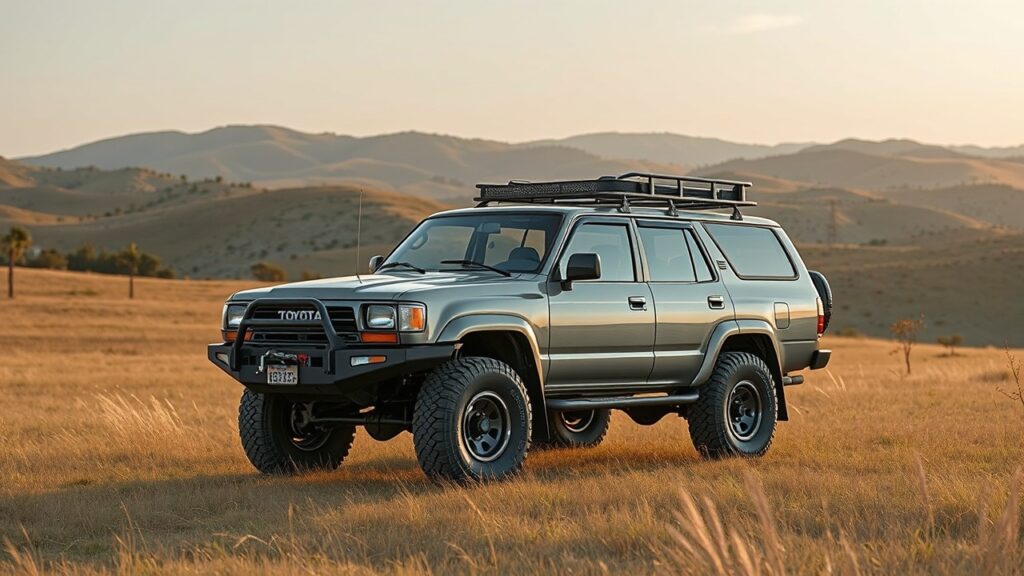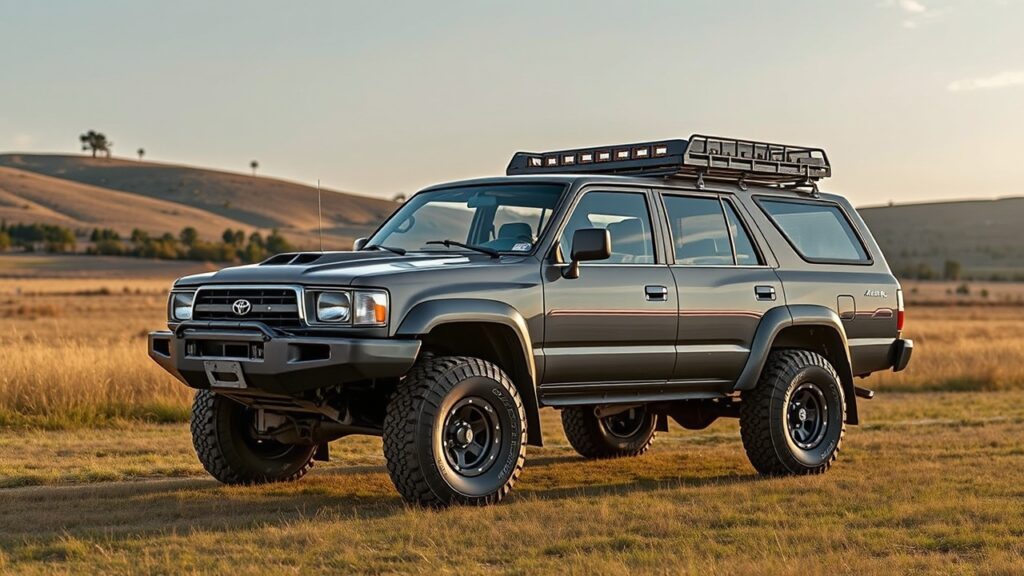The 1988 Toyota 4Runner is a revered model, especially for off-road enthusiasts, thanks to its rugged build and reliability.
When it comes to modifying or maintaining your 4Runner, understanding its axle gear ratios and tire sizes is crucial. These elements play a significant role in your vehicle’s performance, especially for off-road adventures, towing, and overall drivability.
In this detailed guide, we’ll dive into the specifics of the 1988 Toyota 4Runner’s 4-cylinder gear ratio and tire sizes, covering everything from factory setups to how changes affect your vehicle’s performance.
Axle Gear Ratios
The gear ratio refers to the relationship between the number of teeth on the ring gear and the number of teeth on the pinion gear inside the differential of your vehicle’s axle.
Simply put, the gear ratio determines how many rotations the driveshaft makes for each rotation of the wheels. The ratio has a significant impact on how your 4Runner drives, especially when considering off-roading or towing.

Factory Gear Ratios for the 1988 4Runner 4 Cylinder
For the 1988 Toyota 4Runner with the 4-cylinder engine, the factory gear ratios typically depended on the drivetrain configuration.
This means that whether your 4Runner is equipped with a 4×4 or 4×2 drivetrain will influence the gear ratios. Here are the standard configurations for the axle gear ratios:
- 3.73:1 – This was the most common gear ratio found in 1988 4Runner 4-cylinder models, especially for the 4×4 configurations. A 3.73 ratio is ideal for a balanced driving experience, providing a decent mix of off-road capability and highway efficiency.
- 4.10:1 – The 4.10 ratio was available in some off-road versions or those equipped with larger tires or designed for more robust off-road tasks. A 4.10 gear ratio allows better torque for off-road climbing and towing, but it can reduce fuel efficiency on highways.
How Gear Ratios Affect Performance
Gear ratios have a profound effect on your 4Runner’s performance. Here are some key points on how they influence different driving conditions:
- Acceleration: Lower gear ratios (e.g., 4.10:1) provide more torque to the wheels, which improves acceleration, especially for off-road driving. This is important when navigating steep inclines, loose surfaces, or during rock crawling.
- Fuel Efficiency: Higher gear ratios (e.g., 3.73:1) are better for highway driving. They reduce engine RPM at higher speeds, improving fuel economy.
- Towing: A lower gear ratio like 4.10:1 provides more pulling power, making it ideal for towing heavy loads, such as a camper or a trailer.

Upgrading Your Gear Ratio
If you’ve installed larger tires or plan on using your 4Runner for off-road tasks, you may want to upgrade the gear ratio.
For instance, if you install tires that are larger than stock, you might need to switch to a lower gear ratio to maintain proper engine performance and prevent excessive strain on the drivetrain.
Tire Sizes and Gears
Factory Tire Sizes
The factory tire size for the 1988 Toyota 4Runner 4-cylinder model varied based on trim level and the type of drivetrain (4×4 or 4×2).
However, a common factory tire size was 215/75R15. This tire size works well with the 3.73:1 gear ratio, providing a balanced performance on both on-road and light off-road conditions.
Impact of Tire Size on Gear Ratio
One of the most common modifications owners make to their 4Runner is upgrading the tires for larger ones, especially when going off-roading.
However, changing tire sizes can have a significant impact on the overall gear ratio, which, in turn, affects performance. Here’s how it works:
- Larger Tires: Installing tires that are larger than the stock size (such as 31×10.5R15 or 33×12.5R15) increases the overall diameter of the wheel. Larger tires essentially lower the effective gear ratio, reducing engine torque at the wheels. This can make acceleration slower and reduce fuel economy, as the engine needs to work harder to turn the larger tires.
- Smaller Tires: Conversely, smaller tires increase the effective gear ratio, providing more torque to the wheels. While this can improve acceleration and off-road performance, it can also cause higher RPMs on highways, leading to decreased fuel efficiency and higher engine wear over long distances.
Choosing the Right Tire Size
When choosing tire sizes for your 1988 4Runner, it’s essential to consider the intended use. Here are some tire size options and their implications:
- Stock Size (215/75R15): Ideal for daily driving with a balance of on-road and light off-road capabilities.
- 31×10.5R15: A popular choice for off-road enthusiasts, providing better ground clearance and off-road traction. You might need to upgrade to a 4.10:1 or 4.56:1 gear ratio for optimal performance with these tires.
- 33×12.5R15: These large tires offer excellent off-road performance, especially for deep mud, sand, and rock crawling. A gear ratio of 4.56:1 or 4.88:1 would be ideal to prevent strain on the drivetrain and maintain performance.
Gear Ratio Changes for Larger Tires
If you install tires larger than stock, you’ll likely need to adjust your gear ratio. Here’s a guideline based on tire size and desired performance:
- 215/75R15 (Stock): No gear change necessary.
- 31×10.5R15: If you want to keep your 4Runner’s performance optimized, switching to a 4.10:1 or 4.56:1 gear ratio is recommended.
- 33×12.5R15: For these large tires, a 4.56:1 or 4.88:1 gear ratio is ideal, as it will allow the engine to maintain power and torque without overexertion.
Tuning Your 4Runner for Performance
When modifying the tire size or axle gear ratios, it’s crucial to also recalibrate your speedometer and GPS systems. Installing larger tires will affect the accuracy of your speedometer, as it will display a lower speed than you’re actually going.
GPS systems, especially those integrated into modern off-road packages, might also show discrepancies in distance or speed readings if the vehicle’s tire size is modified significantly. To ensure that your 4Runner is performing optimally, consider investing in a speedometer calibration package.
FAQs
1. What is the stock axle gear ratio for a 1988 4Runner with a 4-cylinder engine?
The stock gear ratio for a 1988 Toyota 4Runner with a 4-cylinder engine is typically 3.73:1. Some models, especially those equipped with larger tires or a more off-road-oriented package, might have a 4.10:1 ratio.
2. What happens if I install larger tires on my 1988 4Runner without changing the gear ratio?
Installing larger tires without adjusting the gear ratio can cause a decrease in engine performance, particularly in terms of acceleration. The vehicle will feel sluggish, especially when driving uphill or towing. Additionally, fuel efficiency may decrease as the engine has to work harder to turn the larger tires.
3. What is the best tire size for off-roading on a 1988 4Runner?
For off-roading, the best tire size for a 1988 4Runner is typically 31×10.5R15 or 33×12.5R15. These tires provide increased ground clearance and better traction on uneven terrain. However, keep in mind that larger tires may require a gear ratio change for optimal performance.
4. Do I need to change my gear ratio if I upgrade my tires?
Yes, if you install larger tires (e.g., 31×10.5R15 or 33×12.5R15), you should ideally change your gear ratio to ensure your 4Runner performs optimally. A 4.10:1 or 4.56:1 ratio would be ideal for most off-road tire upgrades.
5. How do I recalibrate my speedometer after changing tire size?
After changing tire size, recalibrating your speedometer is essential to ensure accurate speed and mileage readings. You can recalibrate the speedometer using a special calibration tool or by having a professional perform the adjustment. Some modern GPS systems can also be programmed to account for tire size changes.
Conclusion
The 1988 Toyota 4Runner 4-cylinder offers a robust platform for off-roading and daily driving. Understanding the gear ratios and tire sizes is crucial for maintaining or improving its performance.
Whether you’re towing, off-roading, or simply looking for better fuel economy, adjusting the gear ratio and tire size accordingly can significantly affect your driving experience.
Always consider the trade-offs between power, fuel efficiency, and comfort when making these modifications. With the right balance of axle gear ratio and tire size, your 4Runner can continue to perform at its best for years to come.










